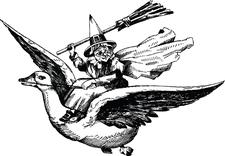Ghostly Mother Goose
 "There is in Springfield quite a considerable section which has long been known as ‘Happy Hollow.’ It lies in the less elevated portion of the town. Its rather indefinite western boundary is somewhere near Boonville or Jefferson Street, from which it extends east and northeast to the Boulevard [National]. The old Belt Line Railroad traverses it and the Jordan flows through it. From the early history of the city this region has been inhabited largely by [Black residents]. In the [1860s], when Springfield was young and built southward from Boonville Hill, this Hollow was a forest. Vast numbers of huge elms, interspersed with dense thickets of undergrowth stood here. It was such a river bottom as one might see in any part of the southwest where the axe and the saw have not been.
"There is in Springfield quite a considerable section which has long been known as ‘Happy Hollow.’ It lies in the less elevated portion of the town. Its rather indefinite western boundary is somewhere near Boonville or Jefferson Street, from which it extends east and northeast to the Boulevard [National]. The old Belt Line Railroad traverses it and the Jordan flows through it. From the early history of the city this region has been inhabited largely by [Black residents]. In the [1860s], when Springfield was young and built southward from Boonville Hill, this Hollow was a forest. Vast numbers of huge elms, interspersed with dense thickets of undergrowth stood here. It was such a river bottom as one might see in any part of the southwest where the axe and the saw have not been.
"This Hollow has had a weird and gruesome history. Its record of horrors began when in 1855, a man by [the] name of Washham, who was accused of killing his stepson in Taney County, was executed in the shadow of its forest by the sheriff of Greene County. Its next tragedy was in 1859 when a [Black resident] was hanged, by an infuriated mob, on one of the great elms. In 1861 the Hollow was made the burial place of fifteen Union soldiers, a portion of the famous Fremont Scouts under the command of Zagoni, a Hungarian and a major in the Union Army. Zagoni met a detachment of Price’s army on the Mt. Vernon Road, which is now Elm Street, in the southwest part of town. A fight ensued and the Union dead were buried here. They were not buried deeply or well. Floods washed many of the bones from the ground. The remains were finally gathered up and interred in the National Cemetery.
"…Why, in the face of its history, it was ever named ‘Happy Hollow’ would be hard to guess. The title must have been bestowed as a piece of grim irony by some daring wit.
"The latest ghost story which has arisen here is as follows: On the evening of September 23, of the present year [1905], Frank Brown, who was a wood and coal hauler for X. Hawkins of Water Street, was walking with his wife along the Belt Line track. It was between sundown and dark. They met a woman. She was dressed in white and kept her face averted. She retreated as they approached, turning from the road. She seemed troubled, they said, and so they stopped and spoke to her. She did not reply but retreated further. They followed to see what the trouble was. She fled. They pursued. She went into an enclosure and they followed. There they had her ‘hemmed in’ and came close to her, when suddenly, and without any place of concealment being near, she vanished, literally faded away in open space and disappeared. The Browns went home troubled. They talked it over. They could not sleep. They were worried. They had seen a ghost. The next day they left town. They said no good-byes, and did not even notify Mr. Hawkins. They simply could not live in the fateful Hollow any longer. A reporter heard of it. He interviewed Mr. Hawkins who gave him some clews [sic]. He hunted them down and found that this ghost had been seen by [many] of the inhabitants of the Hollow. The apparition is appearing regularly these days, or rather, these nights. Several testified to the visual manifestation of the wraith.
"The generally accepted story of this particular spirit seems to be this. About 30 years ago there lived in the Hollow an old woman who went by the name of ‘Mother Goose’. If she had any other name it is not known. She was called Mother Goose because she kept a great flock of geese. These geese would follow her around. They were her constant companions. She used to go up to the city lot and pick up corn off the ground for them. After a while she disappeared. No one knew when or how or why she went. She was simply gone. Now they say she has returned in this ghostly guise and is looking for her flock.
"If it is really the shade of Mother Goose that is thus ‘revisiting the glimpses of the moon.’ It would be a kindness to the habitants of the Hollow if someone would furnish her a flock of geese and permit her troubled spirit to return to the dim land of dreams.
"Such is the story as it has been told to us and as it might be told to any curious reader who may care to investigate.”
This article was originally published in the Springfield Missouri Republican on October 6, 1905.
Find this article at